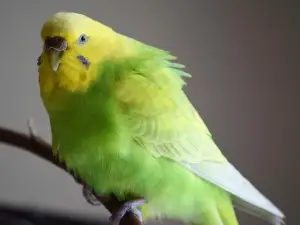
The beaks of parakeets usually range in color from yellow to dark grey, but black on your bird’s beak is quite odd.
This article is a look into why your parakeet has suddenly developed a black spot on its beak
Table of Contents
Black spot on parakeets beak:
You’re probably used to your parakeet looking a specific color so a change in how your bird looks is likely very concerning to you.
Especially if this change is as dramatic as the bird developing a black spot on its beak.
Here are reasons why this may be happening with your bird:
Pieces of food:
The black spot on your bird’s beak may simply be a piece of food stuck and dried up to the beak.
If the bird has recently been eating dark-colored food, and didn’t wipe its beak off as it normally does, then the food may become stuck to and dry onto the beak.
What to do:
Removing this will be as easy as using a damp cloth to dampen the bit of food to make it easier to remove and then gently wiping the food off of the bird’s beak.
A bruise:
If your bird has injured its beak then a bruise may form if the injury was severe enough.
Bird beaks are made up of keratin on the top layer and tissue, blood vessels, and bone underneath.
The injury may have been so severe that it broke the blood vessels and caused bleeding which would initially be red but turn black.
What to do:
If the bird is going about its day normally then the bird will be fine and the bruise will heal with no issue.
However, you’d need to take the bird to the vet to be prescribed pain medications if the bird is in so much pain that it can’t eat anymore.
Wear and tear:
Your bird’s beak is maintained and kept in shape as the bird uses it, the keratin is smoothed down through constant filling, the bird files its beak as it uses it.
However, if the bird rubs its beak on something too often, like on its perch or cage bars, then the bird may develop a black spot in the area because of all this wear and tear.
What to do:
This is not normal behavior and if the bird has enough materials to file its beak down using then this added beak rubbing may be cause for concern.
You may want to take your bird to the vet to figure out why this is happening with your bird.
Fatty liver:
Fatty liver disease develops when a bird eats a diet that is mainly based on seeds, one of the symptoms of this disease is black spots developing on a bird’s beak.
A seed diet, which is high-fat, will cause fat to accumulate on your bird’s liver, this will cause the liver to accumulate fat causing blood clots to appear in different parts of the bird’s body, the beak included.
What to do:
An appointment with the vet is recommended in this case, the vet will not only suggest a change in diet from a high-fat to a low-fat diet, but the vet will also suggest supportive care for your bird and other treatments to get rid of this ailment
If you enjoyed this article then you may also be interested in other bird related articles. Here are some articles that you may be interested in: Brown Spot On Budgies Beak, Black Spots On Cockatiel Beak, Red Spot On Budgies Beak, Stripes On Cockatiel Beak, Why Is My Ringnecks Beak Black?

